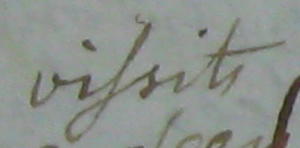The transcription of an archival document is not possible without contextual knowledge that the artefact is submerged in. Essentially, the only individual that knows exactly what is written, is the individual who wrote it. Technology today enables us to read a typed document and have no difficulty recognising every letter that is written. Archival documents however, are not as simple to decipher and this is definitely the case with the Powell diary. A major contributing factor is the fact that the author is not sufficient in writing in English. The Moravians are of German decent and this helps to explain why there are many misspellings. Moreover, many of the entries are concerning the local Indian residents and spelling of their names and locations were at the discretion of the Moravian missionaries since Indian language was spoken and not written. An example of this is seen in Figure 1 wherein the Delaware Indians are mentioned and spelt as “Dellawars”.

Another difficulty that was experienced while transcribing was trying to decipher letters that appear differently in the diary than they do today. The cursive “s” in the diary looks more like and “f” and this was at first hard to recognise and obviously made some words seem very foreign. In Figure 2, the word “visit” is written as “viSsit”, which understandably causes some confusion.

Despite the difficulties that presented themselves while transcribing this diary entry, I was still able to complete the transcription and gain an insight into the experiences of Martha Powell.